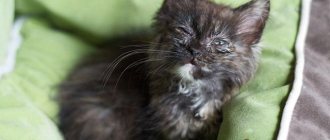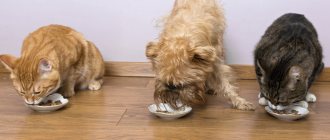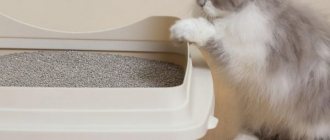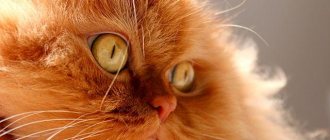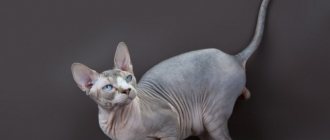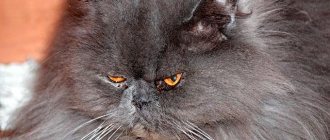11949Pavel
7
Cats are the cleanest pets, washing themselves thoroughly after each awakening. They lick the fur and use their paws to “remove” dried brownish crusts from the corners of their eyes. Usually the owner does not notice such formations, but when a cat’s eyes fester, discharge from them and souring become constant and clearly visible. This symptom is considered dangerous and should be eliminated under the supervision of a veterinarian. Why does such a pathology develop, what to do, what should be used to treat a pet whose eyes are festering? Find out the answers to these questions by reading the article.
Possible causes of purulent discharge
Choosing the right treatment depends on the nature of the problem and the factors that caused it. Among the most likely:
- Eye injuries in cats. This often happens in fights or games, during unsuccessful jumps and other accidents. Then purulent inflammation may develop in the damaged area.
- Entry of foreign objects. Theoretically, any foreign speck can stick to the cornea, get stuck in the conjunctiva and lead to irritation and infection.
- Allergic reactions. Although they are not accompanied by suppuration, the resulting itching of the eyes contributes well to the entry and attachment of bacteria that cause purulent processes. If we talk about the causes of allergies in pets, it can be caused by certain foods, fumes from household chemicals, dust and cigarette smoke, mold particles and insect secretions.
- Conjunctivitis. In cats, they are divided depending on the causes, similar to eye inflammation in humans. That is, they can be caused by viruses, fungi, and pathogenic bacteria. Abundant purulent discharge is often colored yellow and greenish. If the eyes are severely damaged, a pinkish color may appear due to blood impurities. All this leads to a painful state for the pet.
- Keratitis is just as painful. Inflammation of the cornea often begins after injuries and burns, but the causes can also be physiological.
- Complications in the eyes after infections of other internal organs.
It is important to know that with diseases both eyes fester. In case of injury and debris, only one. Colds can be distinguished by the fact that rotting eyes are accompanied by a runny nose. Acute gastrointestinal infections occur with vomiting and intestinal disorders. When other organs are affected, fever often occurs. But even without this, the animal feels great discomfort from bright light, loses appetite and constantly rubs its eyes with its paws.
Reasons Why Cats Have Pus in Their Eyes
A cat can have many such reasons. It is necessary to keep in mind that if a cat’s eyes are watery and purulent, this is not a reason for your concern, especially if these discharges from the eyes are quite rare. When assessing discharge from the eyes, it is necessary to take into account the characteristics of these discharges. If lacrimation is simple, then this is a normal phenomenon for a cat, but if you notice pus in the eyes, then this is already a cause for concern.
The most common disease in which cats' eyes fester is conjunctivitis..
Conjunctivitis is an inflammation of the clear mucous membrane of the eye that covers the back of the cat's eyelids and the front of the eyeball to the cornea. With conjunctivitis, the cat becomes depressed, tends to lie down more, and appetite decreases. The purulent form of conjunctivitis is additionally characterized by an increase in body temperature; from the affected eye we note the release of yellow or green exudate - pus. If emergency treatment measures are not taken, the affected eye stops opening completely, the eyelid may be covered with a thick, dense yellow crust, and the eyelids stick together. The skin around the inflamed eye becomes wet, with further hair loss.
The causes of conjunctivitis are varied:
- Mechanical eye injuries (fights with relatives, blows from branches while jumping, exposure to dust, sand, injuries, etc.).
- Infectious diseases caused by a variety of bacteria and viruses, in which purulent conjunctivitis is one of the symptoms of a particular disease (infectious rhinotracheitis in cats, chlamydia in cats, mycoplasmosis in cats, bordetellosis in cats, calcivirus infection in cats).
- Invasive diseases (worms in cats, fleas in cats).
- Allergic reactions. The mucous membrane of the eyes is very sensitive to a variety of allergens (pollen, house dust, perfumes, household chemicals, food products that cause an allergic reaction in a cat - food allergies in animals). Contact with chemicals, evaporation of certain chemicals, gases.
- Transition of the inflammatory process from the skin adjacent to the eye.
- Heredity. In cats with parents with eye diseases, the likelihood of eye disease increases by 50%.
- Congenital eye pathologies - a pathologically located bulb, an excessively tightly located lower eyelid or rolled inward, eyelashes growing in several rows (eye diseases in cats).
- Unbalanced diet, feeding, lack of vitamin A in the diet.
Treatment. It is not recommended to self-medicate a sick cat. Considering that pus in a cat’s eyes can be the result of a number of severe infectious diseases, it is necessary to contact your veterinary clinic to make an accurate diagnosis and prescribe appropriate treatment.
Veterinary specialists, after conducting a clinical examination of a sick cat, and, if necessary, additional tests (blood test for infectious diseases, eye examination by an ophthalmologist, etc.) will make an accurate diagnosis and prescribe appropriate treatment.
Treatment will be etiological (the cause of the disease) and at the same time aimed at eliminating the symptoms of the disease that the cat has.
- In case of viral diseases, it will be necessary to treat these diseases first.
- If a cat is affected by invasive diseases, we carry out deworming and flea treatment.
- In cases where a cat has swelling in the eye area, solutions of novocaine and hydrocortisone are prescribed.
- If a cat has severe pain, a novocaine blockade with an antibiotic is used, which helps relieve pain and inflammation in the eye area.
- When the disease becomes acute and the pet feels pain, a course of antibiotic therapy is prescribed in the form of a course of injections.
- In case of traumatic injury to the eye and a foreign body entering the eye, Iris or Levomycetin drops have a good effect.
- For lacrimation, use drops of Albucid, Bars.
Removing Foreign Objects
Most often, upon examination, it is possible to notice a speck in the eye. If you can’t hook it with your fingers or tweezers, and the animal strongly resists, you should act differently by dripping Furacilin dissolved in water, saline solution, or simply boiled water and cooled to room temperature, previously slightly salted, into the inflamed eye.
The cat will begin to blink and help itself with its paws. This way the speck can come out along with the fluid flowing from the eye. Instillation or rinsing with a moistened swab should be repeated until the foreign body leaves the eye.
Blepharitis
It is also one of the ophthalmic conditions plaguing the feline family. Blepharitis is a pathology that causes inflammation of the eyelid. There are many subspecies of this disease, and they often flow into one another. A striking example would be simple blepharitis, in which the eyelids turn red, their edges thicken and scales form. Simple blepharitis often develops into a more severe stage - ulcerative. During the ulcerative stage, the eyelids become covered with purulent plaque, under which ulcerative formations appear. Symptoms characteristic of all forms of blepharitis are itching of the visual organs, tearing and discharge from the eyes. Blepharitis is often confused with conjunctivitis, which is not surprising, since both of these diseases can occur simultaneously and transform into one another. Treatment is strictly medicinal. The cat's eyes are treated with special medications prescribed by a veterinarian. Both antibacterial and antibiotic ointments are used. To soften the crusts, various fatty creams are often used, which allow the affected area to be cleaned after the procedure. If blepharitis has developed due to the fault of microorganisms, the cat cannot do without a course of antibiotics and immunostimulants. Antibiotic therapy will consist not only of ointments, but also of injections.
Home treatment for eye infections
When a cat refuses its favorite food due to purulent discharge from the eyes, one can safely suspect acute inflammation. Most likely, it is infectious in nature and caused by bacteria. In this case, you need to apply antiseptics externally in the form of:
- Washing. For them, solutions and liquids with antibiotic properties are used: the same Furacilin, weakly diluted potassium permanganate, infusions of calendula or chamomile flowers, oak bark decoction, three percent peroxide or Chlohexidine. 3-4 times throughout the day, soak a tampon in one of the listed liquids and wipe your eyes. All solutions must be fresh, especially herbal infusions.
- Burying. Ready-made medications with antibiotic drops should be recommended by a veterinarian. However, in critical situations, you can use drops with Levomycetin Albucid, Tsiprolet, Sulfacetomide at home. Anandin relieves itching, minimizes swelling, and eliminates inflammatory redness. All drugs are used according to their instructions. The usual dosage for a cat is 1 - 2 drops in each eye up to 3 times a day.
- Mazey. This is usually Tetracycline eye ointment. You need to keep your pet's head immobilized, gently rubbing a small amount of the composition, previously placed on the drawn eyelid, twice a day.
Why do a kitten's eyes fester?
Normally, lacrimation is necessary to protect the mucous membrane, remove foreign bodies (dust and dirt), lubricate and moisturize. If the kitten secretes a clear liquid, it will be enough to rinse the baby’s eyes and remove small crusts as necessary.
The reasons for the natural secretion of fluid from a kitten's eyes are:
- Morning tears. They are produced in all animals throughout life, do not leave marks on the fur, and are necessary for clearing the nasolacrimal ducts of clots that have formed during sleep. In this case, you don’t have to rub the kitten’s eyes.
- Protective lacrimation occurs in a more active mode. Here, the release of fluid is more intense due to the need to neutralize a possible threat to the organ of vision. Most often we are talking about specks and dust particles getting on the surface of the mucous membrane or under the eyelids, which usually come out along with the tears. In case of severe contamination, you need to rinse the cat’s eyes and monitor its further well-being. In the vast majority of cases, if timely assistance is provided, this is enough and a visit to the veterinarian is not necessary.
- Allergic reactions, which in animals manifest themselves as eye irritation and can be caused by a strong odor, low-quality products, or contact with household chemicals. The owner must determine the cause of the allergy and then wash the cat's eyes.
The main sign of natural lacrimation in a kitten is a clear liquid that does not form streaks on the fur around the eyes. But if pus appears in the discharge, this is a serious cause for concern. Most often, this is a sign of a serious pathology that cannot be treated at home without the help of a veterinarian.
Eye allergies
It is usually indicated by small purulent drops in the corners of the eyes. But in order for the treatment to be effective, you need to understand which allergen led your pet to this condition. If you do not avoid contact with the irritating substance, your pet's immune system will not recover completely.
You can relieve unpleasant and painful symptoms by washing the eyes and instilling antihistamine drops purchased at a veterinary pharmacy. If home treatment does not produce noticeable results for several days or the pet becomes worse, you should immediately take the cat to a veterinary clinic. You can’t take risks, because the animal may have a dangerous disease that leads to blindness.
Prevention of conjunctivitis
To prevent the development of conjunctivitis in your cat, you should follow a number of measures. For example:
- Try to carry out annual vaccinations and regularly give anthelmintics, since viruses and helminths can be the root cause of the disease.
- Support your pet's immune system with immunomodulatory agents.
- Protect the cat from getting foreign bodies and chemicals into the eyes. Clean more often, handle hygiene products carefully, and put household chemicals away.
- Limit your pet's contact with other animals, especially stray and obviously sick ones.
- Wash and disinfect your hands thoroughly after contact with sick animals before interacting with your pet.
Thus, conjunctivitis in cats is not uncommon. However, there is nothing to worry about; with timely treatment, you can get rid of the disease once and for all.
Diagnosis of the disease
If your pet constantly closes its eye, a veterinarian will find out the reasons. If alarming symptoms are detected, it is necessary to take the cat to the clinic.
Diagnostics includes procedures such as:
- visual acuity test;
- assessment of the general condition of the body;
- examination of the visual organs for damage;
- comparison of symmetrical features (size and shape of pupils, eyelids, eyeballs and slits);
- Ultrasound of the affected area;
- staining test;
- CT or MRI of the brain;
- X-ray of the skull.
Ophthalmological pathology may be a consequence of traumatic brain injury. Therefore, the examination must be comprehensive.
It is recommended to donate blood, urine and feces for analysis. Problems with the eyes can be caused by pathologies of internal organs or parasitic diseases.
Owner's first aid
Of course, when a cat has suppuration, a veterinarian’s consultation is necessary. Only after an examination can a veterinarian make an accurate diagnosis and prescribe appropriate treatment. However, the owner must also be able to provide first aid carried out at home. First of all, rinsing is necessary.
Eye wash
How can you wash your eyes?
- Decoction of chamomile flowers.
- Boric acid solution (2 teaspoons of medicine per half liter of warm boiled water).
- 0.02% solution of furatsilin.
Rinsing is best done together, one person should hold the animal and the other should carry out the procedure, this is necessary so as not to damage the pet’s eyes.
How to wash?
The basic rule: the solution must be warm, you cannot use it hot so that the animal does not get burned. A cotton pad, previously twisted into a tourniquet, is dipped into the medicine, which is then squeezed onto the cat’s diseased organ. You need to wash until all the pus is removed. After each wash, the cotton pads should be changed; it is best if the tourniquet is disposable.
You cannot use dry cotton wool, as it can further injure the eye. You should not replace a cotton pad with cotton swabs. Of course, they are more convenient to use, but the sticks pick up a small amount of solution. After you have finished rinsing, you need to put 1% Tetracycline ointment behind the eyelid.
We use ointment
How to apply ointment correctly?
Before applying the ointment, it must be warmed in your hands; there is no need to make investments with a cold composition:
- One person holds the cat tightly, lying on his side.
- The other, meanwhile, carefully pulls back the animal's lower eyelid.
- Use a special spatula to apply ointment to the lower eyelid.
- Then you need to close the eye and distribute the ointment with light massaging movements.
We use drops
What drops can be used to bury a cat?
In order to treat a cat, you can use different drops, for example, Levomycetin, Sodium Sulfacyl, Diamond Eyes drops.
How to carry out the procedure correctly?
- The cat needs to be laid on its side, and in such a way that the eyeball is directed upward.
- In order to administer the drops, you need to hold your pet firmly so that it does not get injured.
- Drop the medicine, after which the cat will blink vigorously, and the medicine will be distributed in the eyeball.
- Then blot the area with a napkin.
When does a cat need to clean its eyes?
A tiny kitten should be immediately accustomed to regular hygiene practices. For medicinal purposes, purulent and watery eyes are washed at the first sign. The medicine is prescribed by the veterinarian based on the cause of the lacrimation.
Symptoms that indicate that your cat needs to have its eyes cleaned and taken in for an examination:
- regular mucous discharge;
- they contain pus, which “glues” the eyes together;
- the cat is constantly squinting;
- she tries to scratch her eyes with her paw.
These signs indicate that inflammatory processes are occurring in the pet’s body, which require medical intervention. But simple lacrimation cannot be ignored
The procedure requires accuracy and patience. A disease caused by an infection should not be left untreated; in the most severe cases, the pet may lose its vision.
